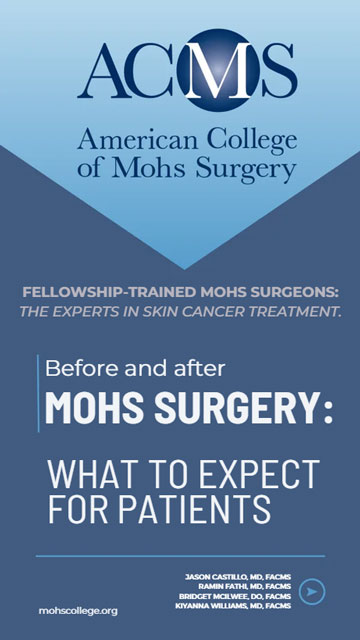Mohs Surgery
Mohs Micrographic Surgery is the most advanced and effective treatment for skin cancer today. The concept of Mohs surgery was developed by Frederick Mohs in the 1930’s but it was popularized by several advances in the 1970’s. Since that time, it has become the standard-of-care for treatment of high-risk skin cancers due to its extremely high cure rate and preservation of normal skin (skin-sparing). Training in this procedure has also become more refined and intensive. Dr. Lane, Dr. Savas and Dr. Clark each completed a 1-year fellowship in Mohs micrographic surgery and advanced skin cancer surgery. This fellowship enabled the surgeons at DSC to become members of the American College of Mohs Surgery, the leading organization involving skin cancer surgery (www.mohs.net).
Mohs surgery is so effective because of the unique way in which the skin cancers are surgically removed, processed and viewed under the microscope. With Mohs surgery, skin cancers are surgically removed and processed in a fashion so that 100% of the surgical margin (edge) may be evaluated under the microscope (see Figure). In traditional non-Mohs techniques only a small representative sample of the removed cancer is viewed under the microscope, increasing the chances that the pathologist might miss positive margins. In Mohs surgery, on the other hand, the surgeon is also trained as the pathologist and looks at 100% of the excised tissue margin under the microscope. Because of this unique processing, the Mohs surgeon is able to tell with certainty if the entire cancer is removed or another “stage” or “layer” is needed to remove more cancerous tissue. In this way, the Mohs surgeon can remove the skin cancer very precisely and accurately, layer by layer, until the entire cancer is removed. Because this technique is so precise, great care is taken that only cancerous tissue is removed and as much healthy tissue as possible is preserved.
After the skin cancer has been successfully removed, another advantage of this procedure is that Dr. Lane, Dr. Olson, Dr. Jenkins and Dr. Savas are all skillful at reconstruction of the surgical defect that remains after Mohs surgery. They have all completed extensive training in facial and skin reconstruction techniques and take great care in their approach to reconstructing wounds that are often in very cosmetically sensitive areas. Although > 95% of the surgical defects are repaired in the office setting by the surgeons at Dermatologic Surgery of the Carolinas, it is sometimes necessary to coordinate more extensive reconstruction with other surgeons.
Indications for Mohs Surgery
Mohs micrographic surgery is typically reserved for high-risk skin cancers that meet certain criteria. Some of these include:
- High risk locations (head, neck, hands, feet, genitalia)
- Large size tumors (> 2 cm on trunk, > 1 cm on head/neck)
- Poorly defined borders
- Recurrent skin cancers (ones that have been treated previously)
- Incompletely excised skin cancers
- Skin cancers in burns, scars, areas of previous radiation
- High-risk skin cancers (rapidly growing, painful, spreading around nerves)
- Certain high-risk subtypes of skin cancer (Dr. Lane, Dr. Olson, Dr. Jenkins, or Dr. Savas) can discuss this further with you)
- Skin cancers in immunosuppressed patients (ie: organ transplant patients)
You and your doctor will evaluate all of these and other features of your skin cancer and decide the best possible treatment in your specific case. Skin cancer is a very heterogenous problem, so it is important to discuss all of the treatment options with your doctor.


